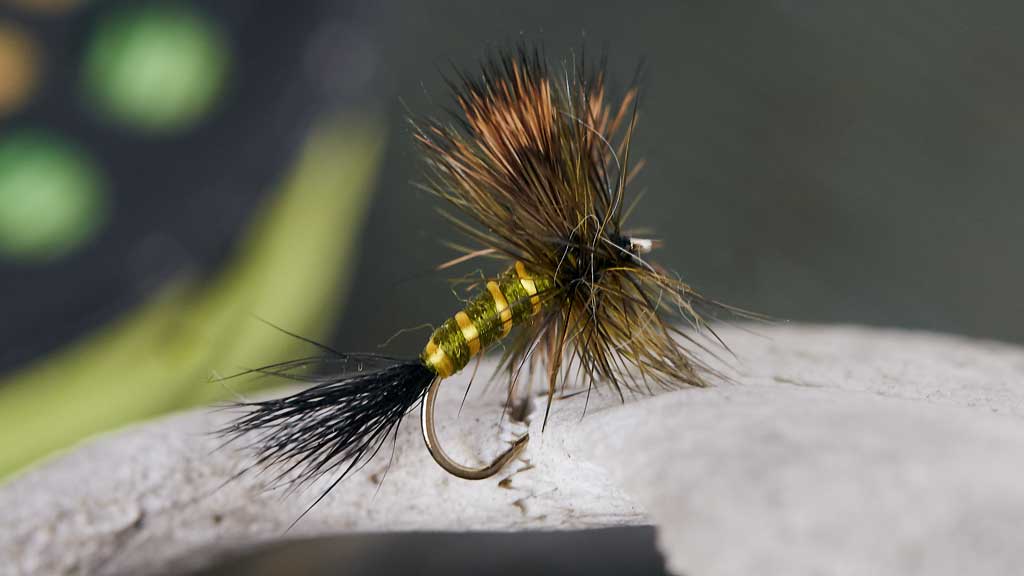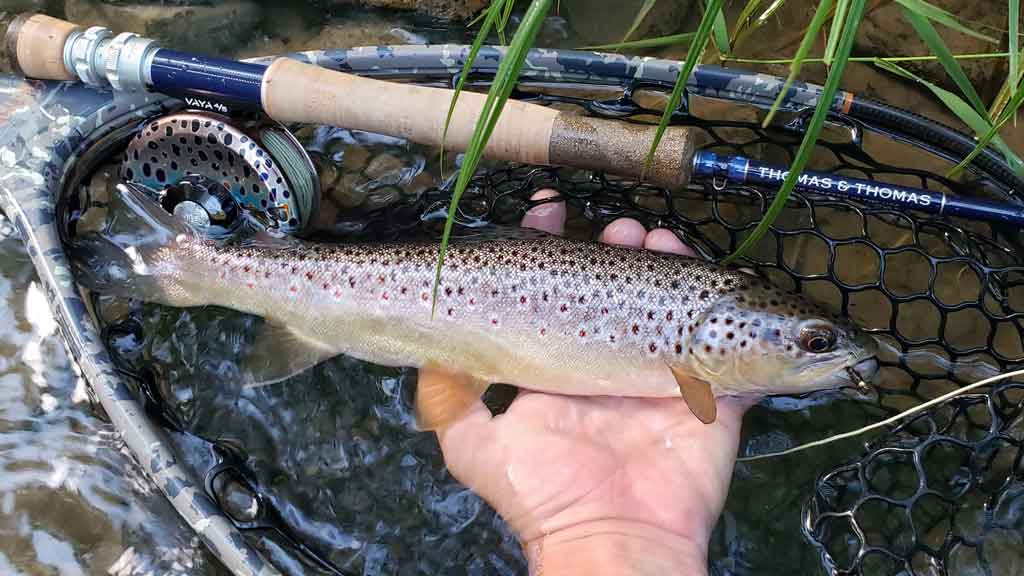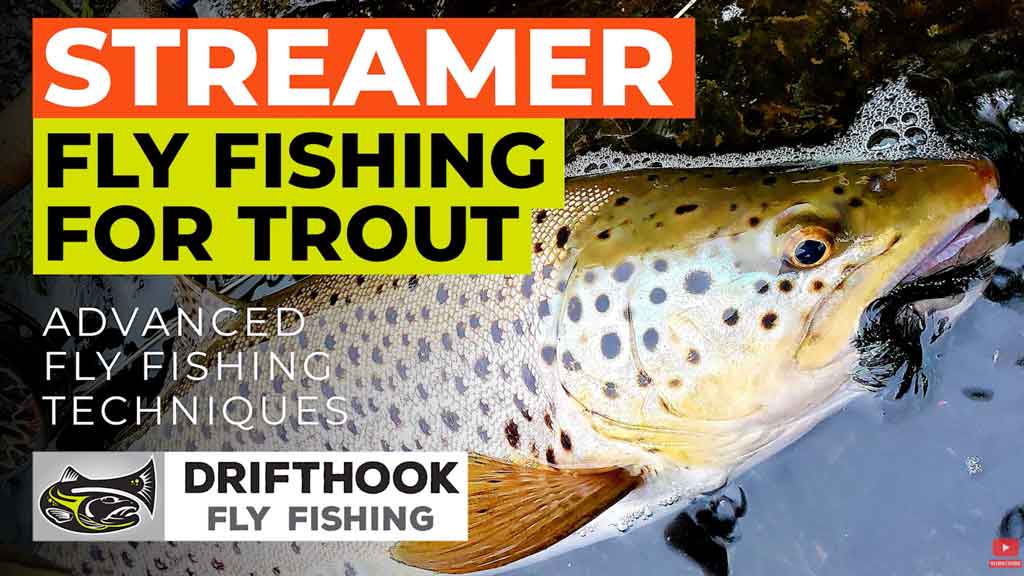A wise man once said, "The best time to fish is when they're biting." There's certainly truth to this bit of understatement, as fish will indeed feed at any hour of the day. However, if you're dry fly fishing, there are particular times of day when fish are more likely to be lured by this type of fly fishing technique.
As a general rule the best time to dry fly fish is the first hour after sunrise and the last hour before sunset. There are many factors such as diurnal cycle, weather patterns and hatch patterns to also consider.

No matter where you are in the world, we all share one thing: a diurnal cycle with light coming up in the east and setting in the west, and many fish species are most active in the hours near dawn and dusk. As we'll be discussing later, this cycle and its associated effects play a significant role in when you should be fly fishing.
Significant Factors to Consider When Dry Fly Fishing
While this article is mainly concerned with the best time of day for fly fishing, a myriad of factors go into that determination. We're going to examine them all, starting with the one you came for:
The Time of Day
Early Morning: This is the time of day when most anglers encounter high activity and are historically considered to be "the best time of day to fish."
Fish will typically start moving up towards the surface an hour or two before sunrise, and it's at this time that they're feeding on insects on the water's surface. If you're fly fishing, you'll undoubtedly want to take advantage of this burst of activity and cast a dry fly. Remember, fish will remain active throughout the entire day, but early mornings tend to be especially good times.
Late Morning: As the sun rises and warms their environment, some fish species (such as trout) will become inactive and retreat to the depths. In freshwater, this is a time when there's typically very little activity from fish.
All of that said, some species will still be active during the later part of the morning and into the early afternoon hours. So if you're fishing a river or stream with multiple deep pools, it may be worth taking advantage of these straggler fish during this time of day.

Midday: During the middle of the day, fish tend to remain inactive when the sun is at its peak in terms of intensity. Depending on where you're located and how hot it gets in your area during the summer months, there will be some activity from local fish in shaded areas of the river or stream where they'll remain cool.
Late Afternoon: The sun is beginning its descent, and the temperatures are cooling, which means that it's time for another burst of activity from local fish species. This burst will typically last until around 7 pm, but depending on the type of fish you're trying to catch, there may be some action even later into the evening.
Evening: As the sun sets and temperatures begin dropping, most fish species will remain inactive until the early hours of the morning. However, there are some exceptions to this rule.

Some fish species come out very early in the evening for short periods of time to feed before bringing their activity level down again as temperatures begin to drop.
Cloud Cover
The amount of cloud cover in your area will have a significant impact on the time of day when you'll catch fish.
During heavy cloud cover, trout become less weary of the bright surroundings and they also are tricked into thinking the safety of night is coming. Rain can also play a beneficial factor in fly fishing for trout as it gives you more cover to get closer to them.
When it's partially cloudy, fish will begin to feed in the shallow areas and near the shorelines because there's less risk of predators coming to attack them. So if you're fly fishing, try targeting these active nodes during this time.
During periods of light to no cloud cover, the heat from the sun is able to warm the environment, which means that fish are much more likely to move up into their shallow water regions and feed on insects at the surface. If you're fly fishing, this is a time when your dry fly will be most visible to fish, and it's highly recommended that you take advantage of these active periods.
The Moon's Cycle
Like everything in nature, fish are heavily influenced by the cycle of the moon. This is not surprising, given the moon's influence on their natural habitat, the water.
Full Moon: Fish tend not to feed when the moon is full, as the light makes them particularly vulnerable to predators. However, during the new moon, fish are more likely to feed insects since there's not as much light. So if you're fly fishing for trout or other fish that rely heavily on bugs to survive, consider targeting this time of night and take advantage of their heightened activity levels.
Half Moon: During a half or crescent moon, fish feed in the shallow waters and near shorelines in low light conditions. If you're fly fishing, this is a great time to target these active nodes.
Waning Moon: When the moon begins to wane, fish become less active because there's more potential for predators, which is why you should avoid fishing during this time if possible.

The Weather
Weather conditions don't just affect you as a fisherman. They also play a major role in fish behavior.
Light and Cloud Cover: Most fish species don't tend to feed during periods of heavy cloud cover or when the sun is high in the sky because it's far too hot for them to remain active.
Wind Conditions: When there is significant wind fish tend to stay in the deep water parts of their environment. This a tuff time for fly fishing since casting will be significantly more challenging.

The Seasons
The particular season you are in will factor heavily into that time of day is the best for fly fishing.
Spring: During spring, you can expect to experience a wide range of weather conditions depending on the time of day, making it difficult to predict the best time for fly fishing. However, if you have a warm, calm day on your hand (meaning low winds and fair weather), early in the morning or just before dark is usually a good time to target fish feeding on insects.
Summer: Early mornings and late evenings tend to be the best times of day during summer because it's too hot for fish species to feed during mid-day hours. Fishing mid-day can be productive when there's light cloud cover, but it's much better to fish before or after the peak hours of sunlight.
Fall: During this season, you can expect heavy cloud cover in the early mornings and late evenings, which is a perfect time to target fish species. Most fish will begin feeding earlier in the evening when it's still relatively warm out and remain active until temperatures become too cold for them.
Winter: The best time of day for fly fishing during this season is from around nine in the morning until four in the afternoon because it's too cold for fish to remain active. If you're fly fishing during this time, it's best to use light tippet with midge dry fly patterns.

Water Temperature
Another major factor in determining what time of day is best for fly fishing has to do with the temperature of the water. As it heats up, so does the fish's metabolism. This means they become more active throughout the day, especially in the heat of the summer.
At lower temperatures, on the other hand, fish are relatively lethargic. They don't move around much at first light and will spend most of their time on or near the bottom of a body of water.
The diurnal cycle is also important to consider when it comes to temperature. For example, as the sun rises, the ground heats up and produces heat of its own. This causes a domino effect where the earth, air, and water all warm-up at the surface.
The sun is also a major factor in determining how warm a body of water gets throughout the day. This is because water absorbs a lot more light than land does, and it's constantly cooled by wind and rainfall.
Just remember:
- Warmer temperatures (and more sunlight) will make fish more active early and late in the day.
- Colder temperatures (and less sunlight) will make fish most active during the warmest part of the day.
Water temperature also dramatically affects the movement and behavior of fish. So make sure you pay attention not only to the temperature at a given time but also to how it changes throughout the day.

The Effect of Light on Fish Behavior
There's no getting around it, fish are active during the day. As we've discussed, fish are most active when it's warmer and there's more sunlight, but that doesn't mean that nighttime is devoid of fish activity.
However, fish go out of their way to avoid bright lights at night. They'll use shadows along the shore or in deeper water to their advantage in this regard. Even when there isn't anything in the way, fish are naturally skittish. They tend to avoid well-lit areas because they can easily be seen by predators like birds and other fish looking for an easy meal.
The Final Word on the Best Time of Day for Dry Fly Fishing
Based on all the factors we examined above, it's safe to say that early morning and just before darkness offers the best conditions for dry fly fishing. Most fish are out of the safety of their habitat when they're feeding at dawn and dusk, making them easier to spot. Also, there's enough light to see, fish are active, and it's easy for an experienced angler to get closer without spooking them.

About the Author
Matthew Bernhardt, a third-generation Coloradan, grew up at the forefront of the state’s fly-fishing revolution, enjoying time on the water, side by side with experienced guides and lifelong anglers.
By combining his passion for fly-fishing with input from other experienced fly-fishers and guides and his fine arts degree from Colorado State University, Matthew spent five years carefully developing the Drifthook Fly Fishing System, built to help every angler catch more trout.
When he’s not spending time with his wonderful family, you’ll find him out on the water catching MONSTER trout, and he anxiously looks forward to the day when his kids are old enough to join him there.




